Ashish Bagai chronicles the History of the IAF’s first Helicopter – the Sikorsky S-55 Whirlwind.
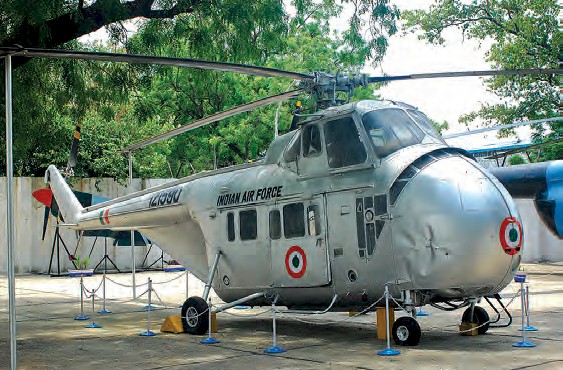
Between 1954 and 1957, the Indian Air Force took delivery of three Sikorsky S-55™ and two S-55C aircraft. These were the earliest helicopter types acquired by the IAF, with Sikorsky Aircraft being the first manufacturer to support the requirements of the Indian Supply Mission. While the S-55 helicopters that were operated by the IAF have long since been retired, and most of them lost to the spoils of time, at least one ship remains: Construction Number 551077, Registration IZ1590, can still be viewed at the Indian Air Force Museum in New Delhi, as shown above. This article was the final S-55 aircraft purchased by the IAF (at a price of $137,500 in 1957), and although it sports a shiny coat of silver paint, the capable and once well-used aircraft now sits fragile.
The Helicopter Comes to India
Sikorsky built some 1,281 S-55 models, mostly for the U.S. armed services. Many were also exported, and well over 400 manufactured under license in other countries. The type was built in both civil and military variants. Between 1954 and 1957, the IAF purchased five S-55 helicopters, of which the latter two were “C” models. The construction and registration numbers of these aircraft are listed in Table 1 (Below). In relative terms, the five aircraft acquired by the IAF were but a small percent of the total S-55s sold by Sikorsky, but they constituted a significant enhancement in capabilities for the air force of a Republic that was only four years old. The acquisition of IZ648 in 1954 heralded the creation of the first Helicopter Flight within the IAF, and in 1958 become established as the first dedicated Helicopter Unit, Number 104 Helicopter Unit (HU).
| Model | Cons | IAF Serial | Delivery Date |
| S-55 | 55584 | IZ 648 | Jan 1954 |
| S-55 | 55727 | IZ 649 | Jun 1954 |
| S-55 | 55770 | IZ 650 | Sep 1956 |
| S-55C | 551067 | IZ 1589 | Apr 1957 |
| S-55C | 551077 | IZ 1590 | Apr 1957 |
Table 1: Construction Numbers of the S-55 Helicopters acquired by the IAF (Courtesy: Igor I Sikorsky Historical Archives)
IZ648 arrived by ship in Bombay on March 19, 1954. The aircraft was readied and flight tested within five days and then ferried to Delhi on March 25. It was put into service almost immediately, and on March 28, the helicopter was used to transport India’s first Prime Minister, Jawahar Lal Nehru, from Palam to Tilpat range. A rare, but well preserved photograph of the prime minister stepping out of the aircraft is shown in Figure 2. The caption on the back of the photo reads:
“The photograph shows the Prime Minister of India alighting from the helicopter upon his arrival at Tilp[a]t bombing and gunnery range, where the Indian Air Force was putting on an air display in celebration of the 21st anniversary of the I.A.F. The Prime Minister was flown from the Palam Airport, where he had arrived by airplane. Upon completion of the show, he was returned to Palam by helicopter. From left to right in the photo are: an unidentified spectator; Flight Lieutenant K.M. Pannicker; Air Marshal S. Mukerji, CinC of the I.A.F.; Mr. Shri Mahavir Tyagi; Minister for Defence Organization; and the Prime Minister, Mr. Jawaharlal Nehru. Pilot of the helicopter is Flt. Lieut. A. Neil Todd of the I.A.F.”
The aircraft was co-piloted by Flt. Lt. S. K. Majumdar. The IAF commissioned its first squadron on April 1, 1933 and celebrated the date as its anniversary.
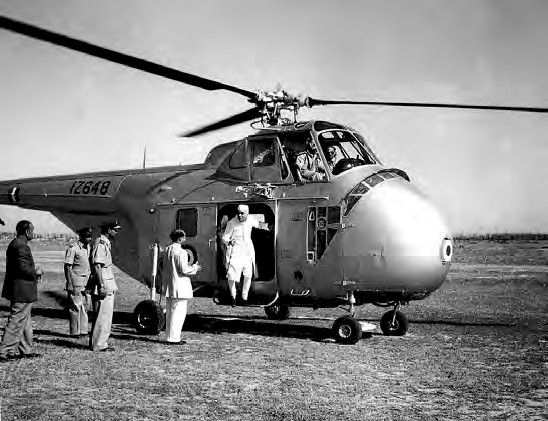
The photograph also includes a handwritten note stating that it was “sent in” in May 1954, placing its date of creation some time prior to then. However, by some accounts the demonstration at Tilpat range occurred a few days later – on the first of April, while still others place the date on April 4, 1954. Indeed, the reference to the latter date (“My Time with the Tigers,” http://tkstales.wordpress.com ) also suggests that the VVIP flight occurred under more exciting and urgent circumstances, whereby the PM was perhaps “rescued” by helicopter to Tilpat, as the author (humorously) reminisces in his blog on the matter:
“Tilpat Firepower Demonstration was planned as a major PR exercise. The prime minister was expected to attend. The show included routine gunnery by the various Vampire and Toofani [fighter aircraft] units. The lone Spitfire Squadron 14 and the lone Tempest Squadron 4 were also to take part. There was to be a demonstration Para[trooper] drop by Dakotas from Agra. Liberators were to demonstrate a World War 2 vintage “Carpet Bombing” in loose formation. Everyone was very excited. Most of the aircraft were to operate from Palam. The technical area of the airfield was full of visiting aircraft. Unfortunately, the media did not show much interest in the initial stages. There was a doubt whether Tilpat, which was poorly connected to the city, would attract enough of a crowd for the event. It was therefore decided to airdrop leaflets announcing the event over Delhi city. This drop, from two Harvard aircraft of the communication squadron, coincided with the final dress rehearsal at Tilpat where 8 Liberators dropped 4 one thousand pound bombs each live. The noise of 32 bombs going off at Tilpat was clearly audible in the city. This triggered tremendous public curiosity. People decided to visit Tilpat by their thousands. Sunday, 4th Apr 54 was a memorable day. By the middle of the night people set course to reach Tilpat by early morning in all sorts of transports. Buses, trucks, cars, phatphatias, tongas, cycle-rickshaws, and bicycles choked the road to Faridabad and beyond. The Prime Minister was trapped in his car in the middle of the road and neither the Delhi Police nor the Punjab police could do anything about it. There was utter panic about the situation. Ultimately it was decided that the PM would be extricated by a helicopter. No. 104 Helicopter Unit was the only helicopter unit in the country. It was based at Palam and was standing by for show related duties. One helicopter was dispatched. The PM was found, extricated and was taken to Tilpat.
Of course, the author clarified that his recollections were based on memories from the time and may vary somewhat from data presented elsewhere. Nevertheless, information and details on the events from the day are scarce, and the account offered here is certainly a worthwhile consideration.
Operational Usage
The S-55 helicopters were used by the IAF for a multitude of utilitarian, support, search and rescue, and VIP transport tasks. In fact, IZ648 was called into action to perform air-rescue operations during its very first year of service with the IAF. In 1954, the flooding of the Yamuna River necessitated the air lift of some fifteen stranded villagers who were suddenly caught surrounded by rapidly rising waters. IZ648, piloted by Flt. Lt. A. N. Todd (it is unclear who his co-pilot was), was used in the dramatic rescue that ensued. The aircraft, with a capacity of two crew members and no more than ten passengers, must have had to make more than one trip to drop off the rescued, before returning for the rest. All fifteen persons were saved, and thus was heralded the IAF helicopters’ “missions of mercy,” a task that Igor Sikorsky also always took pride in highlighting as a salient capability of the helicopter – a capability that distinguished rotary-wing aircraft from their fixed-wing brethren.
The rescue hoist on the S-55 was mounted on the starboard side of the aircraft, above the large sliding cabin door and in clear view from the right seat of the cockpit. It is clearly visible in the photograph shown below. The photograph depicts a rather dramatic demonstration of a helicopter air-sea rescue – this one in celebration of the 27th anniversary of the IAF. It is not clear which particular S-55 aircraft this is for lack of any visible registration markings, although the S-55C models in IAF service did not have rescue hoists.
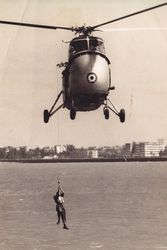
S-55 undertaking a rescue demo off Bombay while marking the 27th Anniversary of the raising of the Indian Air Force.
The usefulness of the helicopter as an air-sea rescue platform was obviously recognized by the Indian Navy as well. The Navy was getting ready to commission its first aircraft carrier – the British Majestic-class carrier, HMS Hercules, which was purchased by the Indian Navy in January 1957 and commissioned in March 1961 as the INS Vikrant – and in 1959 began training its own pilots to fly the Sikorsky aircraft. In 1961, IZ648 was loaned to the Indian Navy to perform rescue and plane guard duties from the Vikrant.
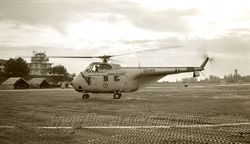
Sikorsky S-55 Whirlwind [IZ648] on loan from the Indian Air Force. This helicopter was later lost in a ditching accident in the Ernakulam Canal. (David Taylor)
The aircraft even journeyed with the carrier to RAF Changi (Singapore) in August 1962 where it didn’t go unnoticed. IZ648 was spotted operating to and from the base, and was even used in the recovery of an IN Sea Hawk jet fighter that was stranded due to engine trouble. The aircraft is shown having arrived at RAF Changi in Figure 4 (top). The helicopter apparently brought a crew chief to the base to help resolve the engine problems that the Sea Hawk was suffering, and is shown taxiing up to the fighter in the center image. The stranded aircraft was later towed down public roads to a suitable area from which it was transported to the carrier. The bottom image shows the lone IZ648 aboard the INS Vikrant as it steams on its way from the Royal Navy dockyard in Singapore. IZ648 was later lost in a ditching accident in Cochin in 1964; nevertheless, it was possibly the most abundantly photographed S-55 of the IAF. Another photograph of IZ648, flying the ensign of the IAF, is shown in Figure 5.

IZ 648 seen flying the IAF ensign
Curiously, little information seems to have survived of the other S-55 aircraft – IZ649 or, for that matter, IZ650, although an IAF photograph of the latter has been published in the literature, and is also shown here in Figure 6. By some accounts, a second helicopter was also loaned to the Indian Navy to serve aboard INS Vikrant, and this was most likely an S-55 model, given the absence of the rescue hoists on the C-models. It is thought that this aircraft was IZ650 but details remain sketchy.
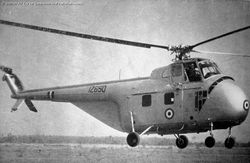
A rare photograph of the IZ650 at Tilpat range in April 1955.
It is possible that IZ649 was short lived for, as Mr. Dan Libertino (president of the Igor I. Sikorsky Historical Archives) recalls, two damaged IAF S-55 airframes were sighted at the Hindustan Aeronautics Limited (HAL) facility in Bangalore in 1957. Mr. Libertino was the Sikorsky technical representative in India at the time of the S-55C deliveries that year. In addition to receiving the two helicopters arriving in Bombay via sea and readying them for acceptance flights (along with Sikorsky test pilot Byron Graham), Mr. Libertino was to assist with the certification of an S-55 repair facility at HAL in Bangalore. It was during his visit to the HAL facility that the S-55 aircraft were discovered – and these were possibly IZ649 and IZ650. Apparently, enough of the two damaged airframes were salvageable to return one aircraft to flight status, and it is indeed plausible (albeit speculative) that this was the resurrection of IZ650, which was then later loaned to the Indian Navy, thereby explaining other references to IZ650, but practically none to IZ649.
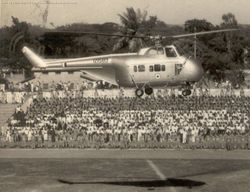
The only known photograph of IZ1589 comes from the collection of late Air Vice Marshal S N Goyal.
Similarly, few details of the IAF S-55C models, IZ1589 and IZ1590 survive, although the aircraft continued to serve with the air force until 1966, and the latter is displayed at the IAF museum in Delhi. The S-55Cs were equipped with more powerful engines than the earlier models, and were used primarily as light utility aircraft at higher altitudes. While there were differences in how the S-55 and S-55C models were configured per customer requirements, the latter also exhibited a fundamental evolutionary maturation compared to its predecessors.
Aircraft Description
The three S-55 models of the IAF (IZ648, IZ649 and IZ650), had straight tail booms and the Pratt & Whitney R-1340-57 engine. The latter two S-55C models, IZ1589 and IZ1590, had tail booms that were canted downward at 3 degrees. An aerodynamic vertical fin replaced the simple tail rotor drive fairing, and cabin windows were added. The horizontal stabilizers were also changed, from a variable incidence, inverted “vee-tail” design, to a fixed incidence, horizontal configuration. A comparison of the empennage sections of the two models is shown in Figure 8. It is worth noting that the variable incidence stabilizer was later locked in position even on the original models (see the locking plate in upper picture).
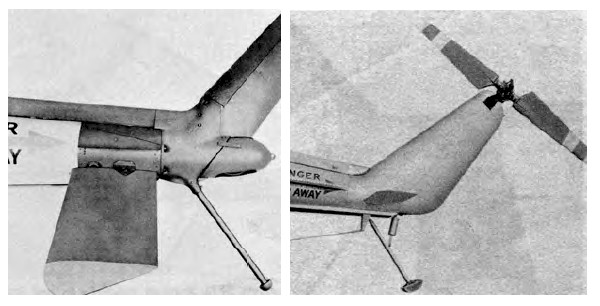
Comparison of tail empennage of S-55 (Left) with that of the S-55C (Right)
General specifications and design characteristics for the S-55C aircraft are provided in Table 2, The internal layout of an S-55 is shown below. The cockpit was accessed via a ladder that led up from the main fuselage, positioning the pilots above the main cabin and the nose-mounted radial engine.
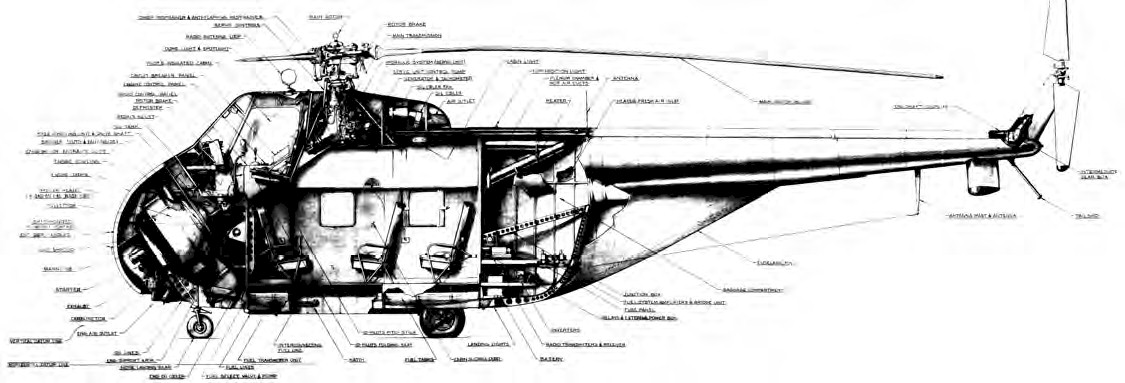
Layout of the S-55
A diagonal drive shaft connected the engine to the main gear box, located in the transmission compartment above the cabin. Fuel was stored in tanks below the cabin floor, and baggage and avionics bays were positioned just aft of the passengers. Indeed, both models were essentially identical in size and internal layout, although the IAF S-55Cs had a more powerful engine. The aircraft had relatively low disk loading and low rotor solidity compared to present designs, giving the helicopter a design blade loading of approximately 0.081 (at standard sea level conditions). The blade spars, which were made from extruded aluminum, were linearly twisted. The NACA 0012 airfoil section was used, which was typical of this first generation technology. The rotor tip speed was 589 ft/s (corresponding to a tip Mach number, MTIP = 0.53 at SLS), a typical value for this era. The rotor disc loading was 3.22 lb/ft2.
Manufacturer specifications for the S-55C indicate that it was typically equipped with the Pratt & Whitney R-1340-57 engine, although it turns out that the IAF S-55Cs had the Wright Aeronautics R-1300-3 engine, which were originally made available on the straight-tail S-55A models. This was a more powerful engine, and presumably desired by the IAF for its improved high altitude performance, giving it a service ceiling of about 11,400 ft at design gross weight (at standard conditions). Engine specifications for the R-1340-57 and R-1300-3 are compared in Table 3. Although the R-1300-3 had fewer cylinders, lower net displacement, and lower pre-compression, it operated at a higher compression ratio and RPM than the Pratt & Whitney engine, and had sufficient power to saturate the gearbox at 700 hp enabling improved high altitude performance.
An information board in front of the IZ1590 at the IAF museum, claims the versatility and capabilities of the S-55s helicopters used by the IAF (the power rating and speed capabilities listed on the display are commensurate with the performance of the S-55C with an R-1300-3 engine but the “R-1500-3” specification appears to be typographically erroneous).
The S-55 Legacy
The aircraft, used extensively during peace and military operations, for VIP transport and refugee evacuations, logistic support and earthquake rescue, served with the IAF for twelve productive years, until they were phased out in 1966. By this time, the IAF had begun inducting other helicopter types into service, such as the Bell 47, Mil Mi-4 and Aerospatiale SA-316 models, which subsequently replaced the IAF S-55s in years to come. However, the Sikorsky S-55 helicopter owns first-place in IAF rotary-wing history.
Acknowledgements
The author gratefully acknowledges the assistance provided by Mr. Dan Libertino of the Igor I. Sikorsky Historical Archives, Mr. Jagan Pillarisetti of bharat-rakshak.com, Mr. David Taylor and Air Commodore T. K. Sen for sharing their memories and providing copies of the photographs published here.
About the Author
Ashish Bagai has B.S., M.S., and Ph.D. degrees in aerospace engineering from the University of Maryland. He is Principal Engineer, Aerodynamics / Systems Engineering at Sikorsky Aircraft.
References
• Mandal, R.K., Ceremonial Glimpses of the Indian Air Force, Ritana Books, 2002.
• Mehra, S.K., Wings of Glory, The Indian Air Force, published by the Indian Oil Corporation.
• Seth, V., The Flying Machines, Indian Air Force 1933 to 1999, Seth Communications, March 2000.
• Sikorsky, S.I., Images of Aviation, The Sikorsky Legacy, Arcadia Publishing, 2007.
• Singh, P., Aircraft of the Indian Air Force, 1933-73, The English Book Store, 1974.
First Published in Vertiflite, Spring 2011 A Publication of the American Helicopter Society International
Copyright © Sikorsky Aircraft Corporation 2010. All Rights Reserved.